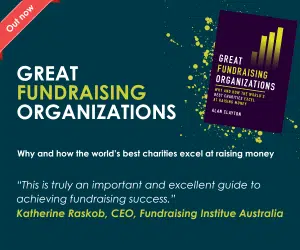Voicing Internet fundraising tips
UK Fundraising’s creator Howard Lake has just published some tips on Internet fundraising for charity chief executives.
The article appears in the June issue of Voice (Voluntary Organisations Information for Chief Executives), the quarterly publication of ACENVO. You can now read the full text of the article below.
Hints on Fundraising on the Internet
by Howard Lake
Advertisement
First published in the June 1998 issue of VOICE, the quarterly publication of ACENVO.
The Internet offers considerable opportunities to charities. They use it to publicise their work, distribute information, communicate with partners, research funders, and to attract and retain donors. So how can you begin to use the Internet to raise funds?
Use the Internet yourself
Get access at home, at a library, at a cyber-cafe or at work.
Send and receive e-mails.
Experience navigating through a Web site to find information you want.
Ask for information by e-mail from a company or charity.
Buy a product online.
Use an auto-responder, an information-on-demand service via e-mail.
Try to search for Web-based information using a search engine or directory.
Research how other charities are using the Internet
Visit other UK charities’ Web sites. There is a list on CAF’s Charitynet Web site.
How are they using them? Which audiences are they addressing? How effective do you think they might be?
Are they fundraising? If so, how? Just a donation form? Or are they gathering information on prospective donors?
How many are using secure donation facilities?
Now visit the Web site of a charity operating in your sector and ask the same questions.
Strategic issues
Consider how the Internet assist your current and planned fundraising activities.
Be clear with your objectives. Are you planning to test an Internet presence, break even, make a profit, or seek to recruit a number of new donors or members?
Which fundraising activities can be transferred to the Internet?
Plan how the fundraising component supports and is supported by the rest of your charity’s Web site material.
Is a secure donations facility essential? Only if your charity receives all its income via credit card donations.
Consider registering your charity’s name as a domain name e.g. oxfam.org. Protecting identity and brand online is essential.
Think how your charity’s name or presence could be misused on the Internet, and plan for this possibility.
The budget for your Web presence must include provision for the planning and staff input phase, creation and implementation of the Web site, and its management, development and promotion over an agreed period.
Production
Will the Web site be published and maintained in-house or by an external agency?
Decide which of your staff will update the site, and how they will do this. Is training required?
Decide how often information will be updated.
Ensure staff understand copyright and libel issues with regard to Web publishing.
Integrate e-mail with your Web site. Use autoresponders and questionnaires, and ask for responses.
Evaluation
Assess the impact of your Web-based fundraising.
Ignore page “hits” as a measure: use page views or impressions.
Make sure all Web-based donation and information request forms are coded to help tracking.
Ask telephone enquirers where they heard about your charity. Was it on the Web?
Current awareness and new developments
Keep reviewing what other charities are doing.
Prepare for telephone/Web page integration, and database-driven personalised Web sites.
Prepare for secure donations by CAF CharityCard.



